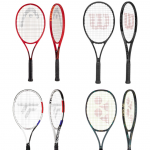Ah, wind. Honestly, I hate playing in it whether I win or lose. Some courts have more trees or nearby buildings to block the wind, while other courts located in open areas constantly have wind. Nevertheless, blustery conditions are inevitable during the outdoor tennis season, and we must adjust our playing style accordingly. As most pros will tell you, it’s about playing smart, high percentage tennis.
With a few tweaks, you can gain the edge over your opponent and make the wind your friend instead of your enemy. Tennis Express shares some tips for you to use the next time you hit the court on a windy day.
Get a Feel for the Wind
Before you begin play, be mindful of which way the wind is blowing. You may notice that it’s easier to serve on one side than the other. Use that information to your advantage, and see if you can secure the side of the court with more favorable wind. The player who’s more mindful of the wind and willing to adapt gains the upper hand in the match.
Serving in the wind
Serving with the Wind
If the wind is at your back, add more topspin to your serve to help bring the ball down and land in the box. The extra spin, aided by the wind, will increase the speed of your serve and make it more difficult for your opponent to return. Also, serve the ball a little lower over the net so it doesn’t go long. Remember that hitting huge flat serves is a risky play on a windy day.
Serving Against the Wind
With the wind in your face, focus on getting your first serve in. If you consistently miss on your first serve, it becomes even easier for your opponent to crush a return on your second serve. The key here is to hit less bomb serves and utilize spin and placement. Take a bit of pace off of the first serve, but still accelerate fully on your swing. If you can make 60-80% of your first serves, you’ll start the point effectively and be ready for the next ball.
Serving in Sideways Wind
If you’re playing in 20+ mph winds, it’s hard to maintain a fluid service motion and focus on your toss. The higher you toss the ball, the more it’s going to move. While it might annoy your opponent, you can always catch your toss and start over.
For righties, if your toss moves to the right, try hitting a slice serve to generate movement. If the wind blows your toss to the left or behind your head, try hitting a heavy kick serve. Mix up these serves depending on which side of the court you’re on and how fast the wind is blowing. A combination of slice and kick serves leads to a higher percentage of serves in, and this will keep your opponent guessing when they attempt to return it.
Groundstrokes in the Wind
Groundstrokes with the Wind
It’s tempting to go for winners, but striking flat balls will often result in unforced errors with the wind at your back. Focus on setting up the point with high, heavy topspin shots. The more topspin you create, the greater margin for error you have. Heavy topspin will also keep your opponent back behind the baseline.
Next, your footwork and court positioning are just as important as your shot selection. Be ready to move forward, anticipating a short ball from your opponent. Know that you have the option to shuffle backwards on the high balls. Let the ball fall into your stroke zone, and attack with consistent topspin. It will be challenging for the opposition to hit good lobs and passing shots against the wind!


Tennis Express Pro Tip: Nobody manages gusty conditions better than Rafael Nadal. In the 2019 French Open semis, Nadal dominated Federer in straight sets in 50 mph swirling winds. Rafa’s footwork has been the key to his sustained success in the wind. He takes many small steps to get in the best position to hit loopy, aggressive topspin groundstrokes, and he makes very few errors. We can all learn from Nadal’s outstanding footwork because small steps are essential in windy conditions.
Groundstrokes Against the Wind
When you’re at the baseline and the wind is coming at you, it’s important to drive through the ball to generate depth in the court. Having high net clearance and hitting heavy topspin are not essential priorities against the wind. Instead, use more slice shots to keep the ball low and out of your opponent’s strike zone. Also, try to take the ball on the rise to neutralize the point. This can be a smart strategy to stay in the rally and force your opponent to overhit. Otherwise, you can get pushed too far back and the ball can fly over your head.
How Much Wind is Too Much for Tennis?
Sometimes, no matter how badly we want to play tennis, the weather just isn’t suitable or even safe to play in. While there are no official rules for when to suspend play for windy weather, you should still exercise caution for safety’s sake. Another thing to keep in mind is the difference between gusty and sustained winds. Just because there’s the occasional bout of 40mph wind on an otherwise clear day doesn’t mean you need to halt the match. Using the Beaufort Wind Scale as a rough guideline, we can plan out our strategy and whether the weather is suitable for play:
Wind Speed Guide
| 0-3 Mph | Calm to light air, play as normal |
| 4-7 Mph | Light breeze, start paying attention to the wind and making adjustments ahead of time |
| 8-18 Mph | Gentle to moderate breeze, be careful of hitting the ball out of bounds |
| 19-31 Mph | Moderate to strong breeze, ball will be carried in the wind. Use more slices and add top spin to keep the ball in play |
| 32+ Mph | Consider suspending play in sustained winds. Becomes difficult to walk in 32 Mph winds, 47 Mph and stronger winds can damage buildings |
Safety Considerations for Playing in Wind
When wind speeds are at a constant 30 Mph, you need to start being mindful of debris. This is important for players and spectators alike, as audience members need to watch out for stray balls headed their way caused by errant winds. Watch out for when speeds hit 55 Mph, as that’s when you have stormy weather. There can be serious damage to outside structures, which can be especially dangerous when playing in an open court such as a park. Seek shelter or call it quits for the day if the windy weather doesn’t let up.
Thanks for checking out our tips on how to play more effectively in the wind. For more ways on how to improve your tennis game, head over to the Tennis Express Buyer’s Guide.
For More:





